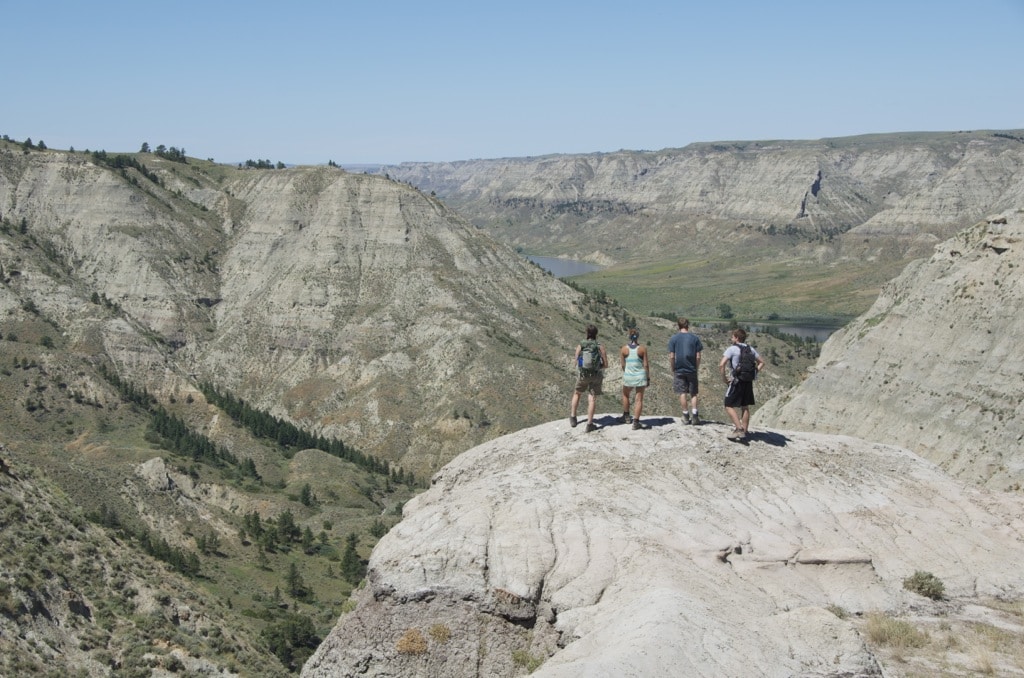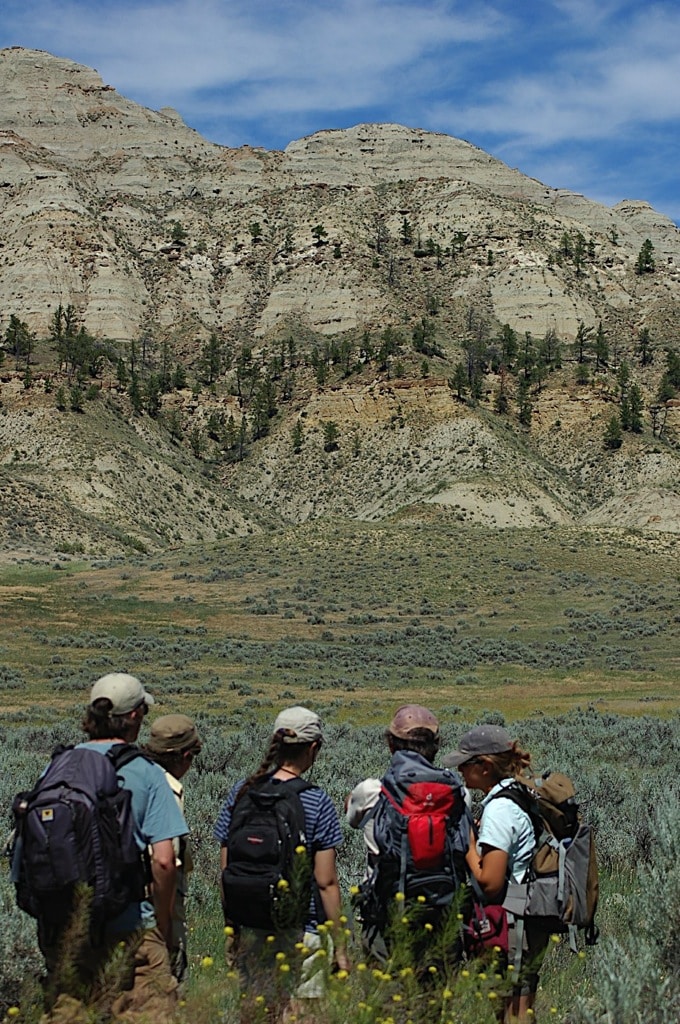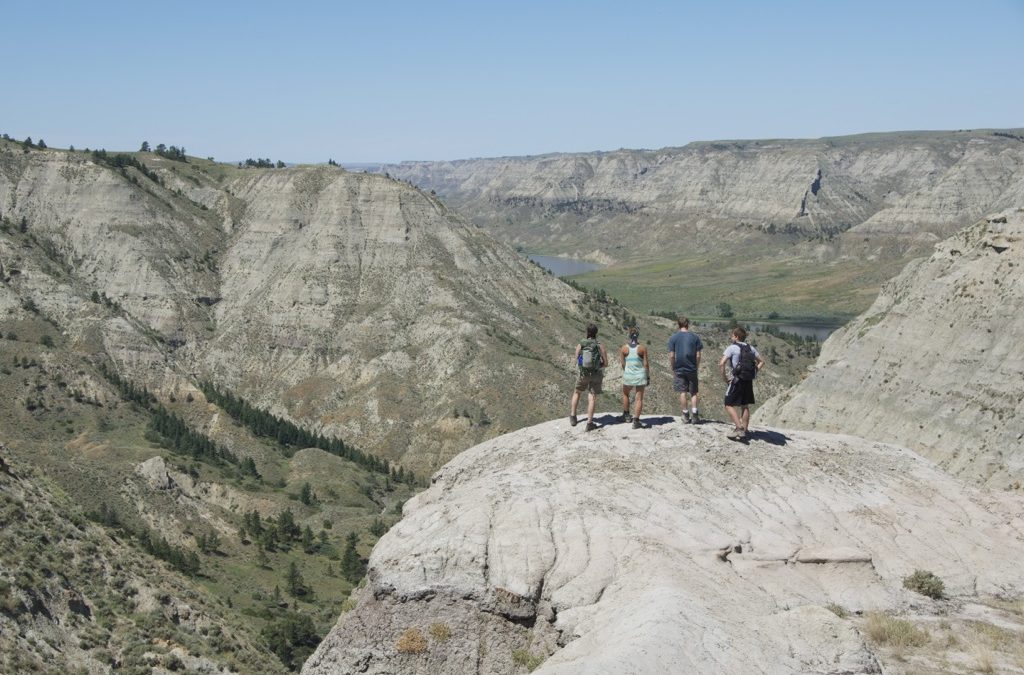Exploring Late Cretaceous Wetland Ecosystems: Dinosaurs and Vertebrate Microfossils in Montana
Overview: Eight students will focus on collecting and interpreting the fossils of backboned animals found in the classic Cretaceous geological record of Montana with an aim of exploring diversity before the mass extinction event that wiped out the dinosaurs. The work will focus on fossils from the Judith River and Hell Creek formations. These formations preserve abundant vertebrate microfossil bonebeds (VMBs), which are concentrated deposits of mostly small bones and teeth from diverse organisms that inhabited ancient swamps and lakes (from tiny fish to giant dinosaurs, and everything in between). Students will work with collections housed at Macalester College and will conduct field and museum-based research in Montana, where they will discover, describe, and sample VMBs. Our work will yield novel insights into coastal plain ecosystems during the final stages of the Late Cretaceous, and will provide new data on a time of significant global change culminating in mass extinction (the K-Pg event).

Students in the field, Upper Missouri River Breaks National Monument
When: June 10 – July 12, 2019 (tentative)
Where: St. Paul/Minneapolis, Minnesota (introduction & lab work), Fort Peck Reservoir (Hell Creek Formation, Montana, field work); Upper Missouri River Breaks National Monument (Judith River Formation, field work), and Museum of the Rockies, Bozeman, Montana (museum research).
Who: Eight students and project leaders Dr. Raymond Rogers (Macalester College, rogers@macalester.edu), and Dr. Kristi Curry Rogers (Macalester College, rogersk@macalester.edu)
Prerequisites and Recommended Courses: Because this experience is for students early in their academic careers there are no specific coursework prerequisites. We are seeking students who are interested in many or all of the following: using field and laboratory methods to explore scientific questions about the ancient Earth, discovering and identifying fossils, understanding how fossils get preserved (taphonomy), using analytical tools to ask questions about organismal paleobiology (bone histology). Students should be comfortable sharing close quarters in tents (including in cold and rainy weather), camping at “primitive campsites” without running water or toilets, canoeing and swimming, hiking several miles in a day, and being without cell phone coverage for up to a week. Students will need to maintain composure in field conditions that are safe but that may include bad weather, difficult trail and boat conditions, and wildlife. Support in the form of field gear loans will be provided to students who do not own their own. All tents and cooking gear will be provided.
Expectations and Obligations:
1. Participation in all project-related work during the summer (approximately June 10-July 12, 2019)
2. Write abstract with team members and present a paper (poster or talk) at the Geological Society of America National Meeting in Phoenix, Arizona September 22-25, 2019 (all expenses covered).
PROJECT DESCRIPTION
This project builds on longstanding research in the Upper Cretaceous, dinosaur-bearing rock record of Montana focused on Vertebrate Microfossil Bonebeds (VMBs) – accumulations of the resilient hard parts (bones and teeth) of ancient organisms (Figure 1). The teeth, scales, and bones preserved in VMBs provide details on the ecology of ancient ecosystems. Our work will include an investigation of fossil collections housed at Macalester College, the Science Museum of Minnesota, and the Museum of the Rockies, and an exploration of the remote Montana landscapes of the Fort Peck Reservoir and Upper Missouri River Breaks National Monument (UMRBNM) in search of new fossil localities (Figure 2).

Figure 1: Carnivorous theropod dinosaur tooth within a vertebrate microfossil bonebed.
VMBs are fairly common in Mesozoic and Cenozoic terrestrial records, where they have been studied to recover the fossils of rare small-bodied organisms. They also serve as an important archive of relative abundance and species richness in ancient vertebrate communities (e.g., Brinkman et al. 2004, 2007; Demar & Breithaupt 2006; Sankey & Baszio 2008). Our Keck project will investigate the taphonomy and paleoecology of a select set of VMBs from classic localities within the Campanian Judith River and Maastrichtian Hell Creek Formation of north-central Montana (e.g., Rogers 1995, 1998; Rogers and Kidwell, 2000; Wilson 2008; Rogers and Brady 2010; Rogers et al. 2016, 2017, 2018). Students participating in this project will compare these classic VMB records from sedimentological, taphonomic, and paleoecological perspectives and work together to determine whether they represent similar formative histories or traveled unique pathways to the fossil record. Students will study VMB collections already housed at Macalester College, the Science Museum of Minnesota, and at the Museum of the Rockies, and they will travel to Montana where they will discover, describe, and sample VMBs in the field. Their efforts to compare and contrast VMBs in these distinctive formations will (1) advance our understanding of how VMBs form, (2) yield novel insights into the composition and structure of coastal plain paleocommunities during the final stages of the Late Cretaceous, and (3) provide new data on a time of significant global change culminating in mass extinction (the K-Pg event).
In addition, students will gain experience in:
1. Describing and interpreting common sedimentary rocks.
2. Identifying vertebrate and invertebrate fossils.
3. Sampling protocols for collecting rocks and fossils in the field.
4. Employing analytical laboratory methods (e.g., scanning electron microscopy, microscopic X-ray Fluorescence, bone histology) to answer questions.
5. Conducting the essential aspects of field work (e.g., maintaining a field notebook, utilizing topographic maps, prospecting, measuring stratigraphic section).
6. Learning to be an effective team member in the field and lab.
7. Producing and disseminating scientific information, especially to professional colleagues through presentation at the Geological Society of America meeting (September 2019).

Figure 2: Exploring Cretaceous exposures in search of fossil localities in the Upper Missouri River Breaks National Monument.
Potential Student Projects: We envision projects centered around VMB taphonomy, fossil identification, and paleohistology. At the outset, students will work as a team to sieve, recover, and identify vertebrate and invertebrate fossils from bulk matrix of the Judith and Hell Creek formations in storage at Macalester College. After some time spent on focused fossil recovery and identification, students will work in pairs to describe and interpret their fossil collections. Specific projects may include:
• Taxonomic characterization of fossil collections. Students with interests in paleoecology and evolution will explore the biodiversity of ancient lakes from the Campanian Judith River Formation and the Maastrichtian Hell Creek Formation. They will tabulate and compare faunal lists (presence/absence and relative abundance) and ultimately reconstruct and compare faunal diversity in Late Cretaceous freshwater ecosystems.
• Histological characterization of fossil collections. Students with interests in paleobiology and paleoecology will study bone histology of known ectotherms (crocodiles, turtles) and endotherms (dinosaurs, birds, mammals). Patterns of bone histology will be described and interpreted in the context of both taxonomy, animal physiology, and potential resource limitations in ancient Cretaceous ecosystems.
• Taphonomic characterization of fossil collections I. Students with interests in fossil preservation and taphonomy will compare bone modification features across formations, including breakage patterns, evidence rounding and abrasion, and tooth marks (and potentially other evidence of feeding/digestion).
• Taphonomic characterization of fossil collections II. Students with interests in fossil preservation and taphonomy will document in detail the size and shape of fossil bones and teeth collected from the Judith River, Two Medicine, and Hell Creek Formations. An automated image analysis approach will be used to capture size data and statistical approaches will be used to test whether the size and/or shape of fossils varies among sites and between formations.

Figure 3: Canoeing in the Upper Missouri River Breaks National Monument.
PROJECT LOGISTICS
Our tentative dates are June 10-July 12, 2019
Weeks 1-2. We’ll meet at Macalester College and students will be housed in dorms on campus until we depart for the field. While at Macalester, the group will dine in the Macalester dining hall, but there will be some opportunities to shop and cook dinners together, independent of the project leaders but with the help of their peer mentor. These weeks will be spent in the classrooms and laboratories at Macalester, where students will be introduced to the project through a series of focused lectures, discussions, hands-on experiences (e.g., fossil ID, methods of taphonomic characterization, bone histology). Students will process fossiliferous matrix and recover and identify fossils, The team will collect data and craft abstracts for the 2019 GSA meeting (to be submitted no later than June 25, 2019).
Weeks 3-4. We’ll depart Macalester and travel to Montana where we’ll visit a number of Cretaceous paleontological localities. During this interval we’ll be camping in remote field areas, canoeing and hiking in the search for new localities, cooking at our campsite, and making new fossil collections along the way. Our extended field excursion will include a stay in the Hell Creek Formation near Jordan, Montana, where we’ll connect with a field team from the University of Washington at their camp on the Fort Peck Reservoir. Here students will explore the K-Pg boundary and work to collect matrix and fossils from important Hell Creek fossil localities. From there, we’ll continue on to the Upper Missouri River Breaks National Monument (UMRBNM), where the Judith River Formation is well exposed. Here we’ll meet colleagues from the Bureau of Land Management in Lewistown, Montana, before heading into the Monument to conduct field research using a flotilla of canoes to access remote sites along the Missouri River (Figures 3, 4). When our work in the Judith River Formation is done, we will end our time in Montana with a trip to the Two Medicine Formation (the upland equivalent of the Judith River Formation) at the classic “Egg Mountain” field site, where the first North American baby dinosaurs were recovered in the 1970s. Finally, our trip will conclude with a stopover at the Museum of the Rockies in Bozeman, where our students will examine VMB collections and meet with museum curators, fossil preparators, and educators.
Week 5. We’ll return to Macalester for our last week so that we can integrate materials collected in the field into the collection, and we will assemble the text and imagery for our GSA poster presentations. While at Macalester, the group will dine in the Macalester dining hall (and perhaps shop and cook some dinners together, independent of the project leaders but with the help of their peer mentor).
Safety
The project directors are experienced field scientists with decades of experience working at these remote field localities. They are familiar with safety issues specifically related to wildlife, rapidly changing weather conditions, and canoeing/hiking. There is little question that there are a host of inherent risks in this proposed work, but we will try to minimize this risk through training, communication, assessment of student abilities, and planning. We’ll have a satellite phone and wilderness first aid kits at all localities in case of emergency. Here we briefly address the most common concerns.
Wildlife: We will spend the bulk of our field time camping in remote regions with wildlife including rattlesnakes, black bears, and mountain lions. Students will be trained by the project directors in camping/hiking safety.
Canoes: To collect samples in remote, roadless areas, we will be canoeing to some field sites. Students are required to wear personal flotation devices at all times, and the river shoreline is always visible. Students will always canoe with at least one other person, with clear communication about the planned route and expected time on the water.
Weather conditions: The weather in the Montana can be quite unpredictable and variable, with some days/nights up to 100° F and others at/near freezing temperatures. Heavy rain and wind, hail, and snow are all possible, as are very hot sunny days. Warm clothing and layers are all necessary, including rain gear. A day pack (medium sized backpack) is important for all students so they can carry sufficient clothing, and food every day, including 2-3 large water bottles. Sunscreen, hats and gloves, sunglasses, and sturdy hiking shoes/boots are key for student safety and comfort.
PROFESSIONAL DEVELOPMENT
This Gateway Keck project will allow students to develop skills that will last long after the summer is over in a challenging, but supportive environment. Working and living together in the field, collaborating to complete a project from start to finish, and beginning to develop a network of friends and colleagues all build resiliency, competencies, and expertise. Students will work on real scientific questions, using standard and state-of-the art field and lab equipment; they will also receive training in professional science communication. In addition, students will have chances to interact with people across the workforce working as professional geoscientists, from graduate students, professors (the PIs, as well colleagues from the University of Washington and Montana State University), museum professionals (at the Science Museum of Minnesota and the Museum of the Rockies), to those in government positions (Bureau of Land Management employees). These interactions will help set the stage for a broadened view of where a degree in the geosciences can take you, and open the door for future possibilities.
Selected References
Brinkman, D.B., D.A. Eberth, & P. J. Currie. 2007. From bonebeds to paleobiology: applications of bonebed data. In: R. R. Rogers, D. A. Eberth, and A. R. Fiorillo (eds.), Bonebeds: Genesis, Analysis, and Paleobiological Significance. University of Chicago Press, Chicago.
Brinkman, D.B., A.P. Russell, D.A. Eberth, & J. Peng. 2004. Vertebrate palaeocommunities of the lower Judith River Group (Campanian) of southeastern Alberta, Canada, as interpreted from microfossil assemblages. Palaeogeography, Palaeoclimatology, Palaeoecology 213:295-313.
Demar, D.G., Jr., & B.H. Breithaupt. 2006. The nonmammalian vertebrate microfossil assemblages of the Mesaverde Formation (Upper Cretaceous, Campanian) of the Wind River and Bighorn Basins, Wyoming. In: S. G. Lucas & R. M. Sullivan (eds.), Late Cretaceous Vertebrates from the Western Interior. Bulletin of the New Mexico Museum of Natural History and Science 35:33-53.
Rogers, R.R. 1995. Sequence stratigraphy and vertebrate taphonomy of the Upper Cretaceous Two Medicine and Judith River Formations, Montana. Unpublished Ph.D. Thesis, University of Chicago, Chicago.
Rogers, R.R. 1998. Sequence analysis of the Upper Cretaceous Two Medicine and Judith River formations, Montana: nonmarine response to the Claggett and Bearpaw marine cycles. Journal of Sedimentary Research 68:615-631.
Rogers, R.R. & M.E. Brady. 2010. Origins of microfossil bonebeds: insights from the Upper Cretaceous Judith River Formation of north-central Montana. Paleobiology 36:80-112.
Rogers, R.R. & S.M. Kidwell. 2000. Associations of vertebrate skeletal concentrations and discontinuity surfaces in terrestrial and shallow marine records: a test in the Cretaceous of Montana. Journal of Geology 108:131-154.
Rogers, R.R., K.A. Curry Rogers, B.C. Bagley, J.J. Goodin, J.H. Hartman, J.T. Thole, & M. Zatoń. 2018. Pushing the record of trematode parasitism of bivalves upstream and back to the Cretaceous. GEOLOGY 46: 431-434.
Rogers, R.R., K.A. Curry Rogers, M.T. Carrano, M. Perez, & A. Regan. 2017. Isotaphonomy in concept and practice: an exploration of vertebrate microfossil bonebeds in the Upper Cretaceous (Campanian) Judith River Formation, north- central Montana. Paleobiology 43:248-273.
Rogers, R.R., S.M. Kidwell, A. Deino, J.P. Mitchell, & K. Nelson. 2016. Age, Correlation, and Lithostratigraphic Revision of the Upper Cretaceous (Campanian) Judith River Formation in its Type Area (north-central Montana), with a Comparison of Low- and High-Accommodation Alluvial Records. Journal of Geology 124:99-135.
Sankey, J.T. & S. Baszio (editors). 2008. Vertebrate Microfossil Assemblages: Their Role in Paleoecology and Paleobiogeography. Indiana University Press, Bloomington.

